International Artist Tito Mangiola
Living in Wellington and Painting with a Purpose
Story by Krista Martinelli
Behind every Tito Mangiola painting or piece of art, there is a story. “His paintings have a lyrical quality to them,” says his wife Leonarda, who teaches art at the Dillon Country Day School. One of the paintings that captured the most attention is named, “An Italian Comedy: Il Bracco Italiano.” The painting is a humorous, in-the-moment criticism of the politics of Italy, where Tito comes from originally. From left to right, he included the players in their roles as “judge,” “politician,” “religious leader,” “dog,” “fly” and “Mafia.” He boldly called out the corrupt forces that were in power, putting a face on each one.
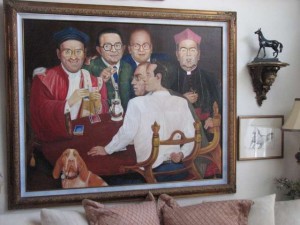
Tito Maan-Mangiola had entered the painting into a national exhibition and competition, not knowing if the judges would appreciate his playful portrait of corruption in Italy. Meanwhile, he had attempted to become a U.S. citizen, but was denied his citizenship.
“I had too many children to be granted my citizenship,” says Tito. He explains that his four children at the time were considered a liability (even though they were all living in Europe), when immigration officials were aiming to keep numbers as low as possible. Meanwhile, Tito won first place for “An Italian Comedy” in the 60th Annual National Exhibition of Contemporary American Paintings in 1999. “As soon as I won that award for that painting, my citizenship was no longer a problem,” says Tito. He was granted citizenship later that same year after winning the award. “I owe my citizenship to this painting,” he says.
Tito lives, breathes, talks and creates art. He is passionate about

many things, including opera, watching polo, entertaining and teaching; however, his drive to create art transcends all else. He decided to become an artist when he was just eight years old. In his Italian school, he found himself getting in trouble with the teachers for being color blind. In fact, in an era when students would get slapped on the hand for things like being left-handed or, in Tito’s case, for being color blind, it was more critical to overcome. Instead of turning him away from art, the punishments he endured made him determined to become an artist.
Learning colors by numbers of calibration and constantly looking them up, Tito worked on his art with painstaking effort. As he began to excel in it, he took more and more classes. “I drove my mother crazy,” says Tito. “I kept switching my major every two years.” He studied oil painting, tapestry, jewelry, wood sculpture and many other arts. This kind of dabbling was not how things were done in Italy at the time, explains Tito. You were expected to choose your major, stick with it and get on with your career. However, Tito’s hunger for more art classes seemed insatiable.
As a child, he lived in Calabria, located in the “tip of the boot” in Southern Italy, a town with “not a lot of money,” according to Tito. While expensive paints and art supplies were hard to come by, it was easy to get a hold of spare chalk, a household item. So Tito began drawing in chalk and selling his chalk drawings for very small amounts or sometimes in even exchange for ice cream. He was inspired by several artists, in particular, Caravaggio and Bruegel.
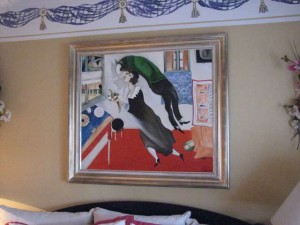
Today in his home in Wellington, Florida, Tito displays many of his own paintings, as well as his homages to various artists like Bruegel, Chagall, Toulouse Lautrec and others. In fact, every inch of Tito and Leonarda’s home is filled with art. They have a deep appreciation for beauty, as well as a sense of humor which contributes some whimsical ceramic items into the mix.
The Village of Wellington proudly displays one of Tito’s trademark mosaic-style paintings. It’s a polo-themed tribute to Wellington and hangs on the wall in the lobby of the Wellington Community Center.

This “faux mosaic” style is an unusual way of oil painting. From afar, it looks like a real mosaic. Tito explains that he generally does a painting in three versions, getting to know his subject quite well by the time he is finished.
A limited edition painting (Epreuve d’Artiste) can be seen at the Palm Beach Airport on the second level. It’s permanently exhibited there, as it was a donation from Tito Mangiola to the community.
In 2007, Tito Mangiola and his family met the former President Jimmy Carter and his wife in Plains, Georgia. For this occasion, he donated a Limited Edition painting entitled, “Excluded World II.” Mangiola was impressed with the accomplishments of President Carter, even after serving as President and delighted with his hospitality. Of course, not all of Mangiola’s paintings take a political stance, but when they do, he has no problem with telling the story exactly as he sees it, often adding a bit of his humor too.
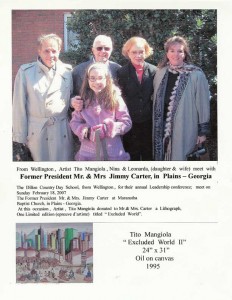
One of his paintings that is loaded with symbolism and possible interpretations is called “In the Name of God.” Sometimes Tito and Leonarda refer to it as the “9/11 painting.” In his own words, Tito explains, “’In the Name of God’ has been for centuries used to justify our means aggressively, resulting in countless acts of destruction and genocide.” He continues, “At the center of this artwork, an Orthodox Serb is aggressively pointing a weapon to try to justify all of the atrocity committed by him or against him. Around him different
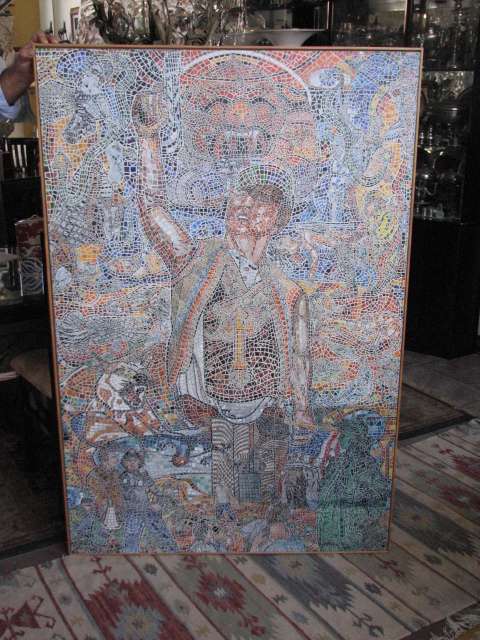
religious symbols mixed with atrocious scenes form a garland of war scenes: Christians, Jews, Muslims’ battles and invasion crusades, as well as the African tribal fight like the Uganda tragedy.” At the bottom of the painting is a depiction of the terrorist attack on the Twin Towers from September 11th. It is a thought-provoking piece that brings to mind the many atrocities that have been committed over the ages, all “in the name of God.”
Tito has lived all over the world and brings an informed and eclectic viewpoint to his art. He grew up in Italy and stayed until the age of 18. He then moved onto Switzerland and lived there for 23 years. He also has lived for shorter periods of time in Austria, Germany, France, Holland and Australia. In 1992, Tito and his wife Leonarda moved to Wellington, Florida. After searching Florida for the right place, they were attracted to Wellington because of the polo and the beauty of the village. They bought two houses, one to live in and one to rent out in the polo season. Tito devotes a good portion of his artworks to the subject of polo and some of these works can be seen on his website under “Equestrian Art.” Tito says that he is fond of inserting horses and dogs into his paintings, whenever possible, as he is fond of both of them.
Both Tito and Leonarda teach art. Tito teaches adult education classes in the evenings at Royal Palm Beach High School, as well as tutoring young students in art in after-school lessons at his own kitchen table. Both are very warm and inviting. They challenge their young students to work on difficult projects, and the students seem to thrive on this.
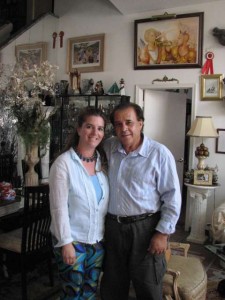
When asked how an artist makes a living in today’s world, Tito laughed and explained, “It’s always a struggle.” He’s always found a way to make ends meet, doing things related to art. In Switzerland, he had a frame factory, as well as two art galleries. Here in the United States, it’s a combination of teaching, managing property and art that keeps the couple busy, and always employed. Tito longs for the days when European churches frequently commissioned art, and art was taken more seriously.
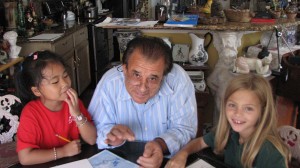
Both Tito and Leonarda enjoy having an open, welcoming house, where friends can come and go freely. When I asked Leonarda if she ever worries about the many fragile pieces of art getting broken during their parties, she simply responds, “You have to enjoy life!” Along with my family, I had the pleasure of joining them on the day after our interview for a birthday party for their 13-year-old daughter Nina. It was an unexpected treat to see a local pianist (who has accompanied Pavarotti in the past) playing songs, while Tito sang along vigorously, inviting everyone to join in. While you might not necessarily catch this from his art (which sometimes has dark undertones), those who know Tito can see that he is one of the friendliest people you will ever meet. He has a true zest for life, which comes through whether he is painting, dancing, singing, drinking wine or just telling a story.
In the next year or so, Tito plans on showing his artwork at a museum in Calabria, Italy (where he originates from). He does have a few commissioned pieces in the works too. His international awards and past exhibits are too numerous to mention, although this link (CJRFineArts.com) gives a good summary. As a professional artist, he does portraits and illustrations, working in a variety of media, but mostly in oil. He can be reached in Wellington at (561) 791-0699. Or visit www.TitoMangiola.com for more information.

